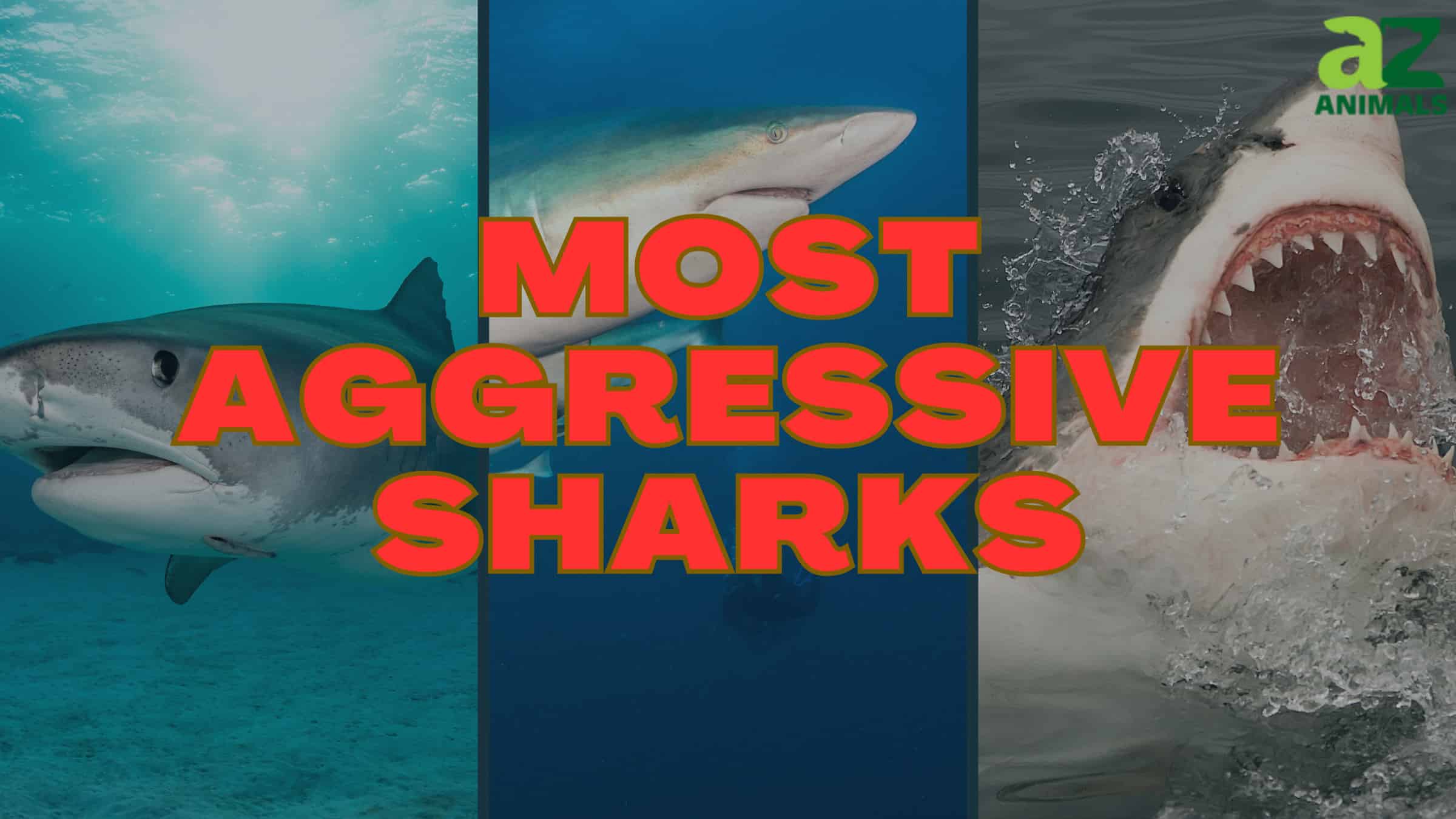Although you’re more likely to get killed by lightning (or even cows who kill about 20 people yearly), the fear of death by a shark attack is universal. Fear of the most aggressive sharks in the world became universal after films like Jaws and The Meg became pop culture hits.
But the subject can be looked at as… Is the glass half-full or half-empty? On the one hand, sharks have only killed an American once every 1.7 years. On the other:
“Between 2007 and 2018, there were 920 shark attacks worldwide and more than half of them were in US waters.”
Business Insider
There are around 500 species of sharks, with more being discovered, but only a small portion of those are seen as highly aggressive. With that in mind, here are seven of the most aggressive shark species in the world examined through the lens of shark attack statistics from the International Shark Attack File.
7. Shortfin Mako Shark
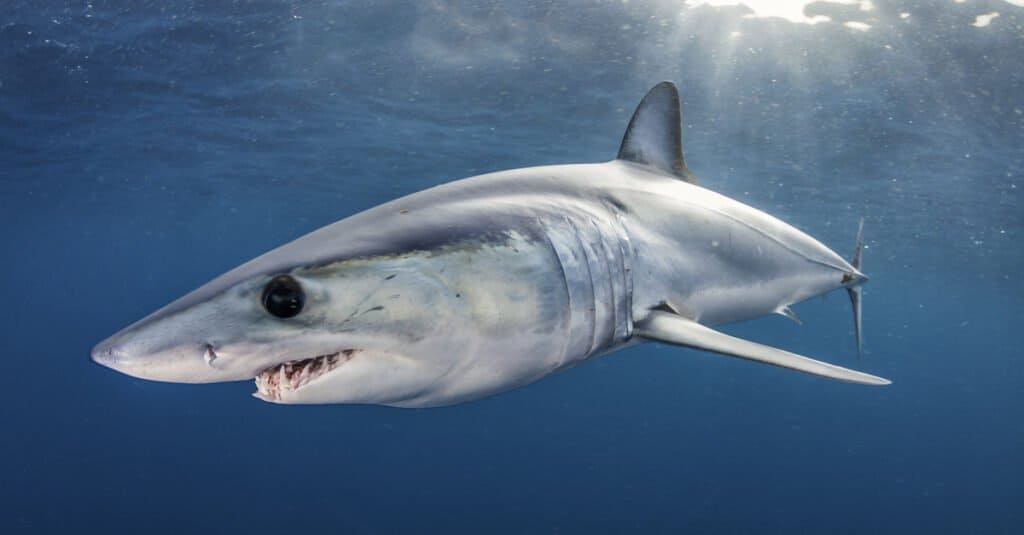
Shortfin makos have 10 recorded attacks on humans with one fatality
©wildestanimal/Shutterstock.com
Arguably, as one of the most menacing-looking of the shark species with its pronounced pointed snout and large black eyes, the shortfin mako stands apart. Their average length is six to seven feet long and they can weigh up to 300 pounds.
Makos don’t rely on electroreception when hunting and instead use their smell, hearing, and vision. They eat mostly:
- Swordfish
- Bluefish
- Tuna
- Other sharks
- Porpoises
- Sea turtles
- Marine mammals
The shortfin mako largely hunts by getting below their prey and looking up so as not to be seen. With the strongest shark bite ever recorded, at roughly 3,000 lbs. of force or 13,000 newtons, most prey never has a chance. The bite was also the second most powerful of any animal on Earth with the first being the crocodile.
Even with that, there are only 10 recorded attacks on humans, including one fatality, by shortfin makos.
6. Great Hammerhead Shark
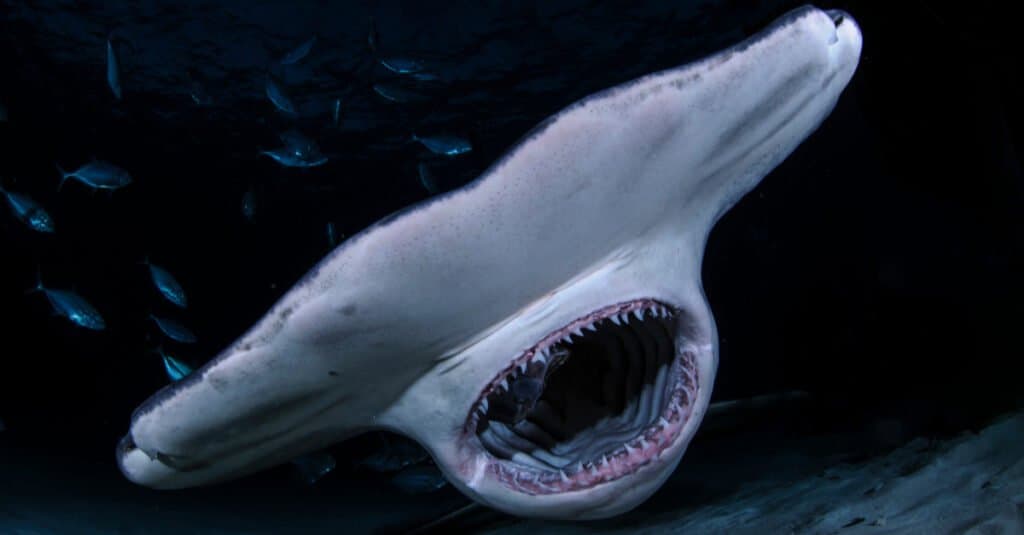
Great hammerheads have 18 attacks on humans with none being fatal.
©Martin Voeller/Shutterstock.com
There are nine different species of hammerhead shark in the world with the largest being the great hammerhead. They’re known for their small mouths, eyes on the sides of their head, and of course the shape of their heads that resemble a hammer.
Hammerheads eat food such as:
They are cannibalistic as well.
Great hammerheads inhabit the waters of the Gulf of Mexico and the Atlantic coasts of Florida. Their average length is 15 ft. but they can reach up to 20 ft. and they weigh over 500 pounds. Much heavier ones at double the weight have been documented, but are rare.
As great hammerheads hunt, they move their heads back and forth to scan the ocean floor for the electrical signals given off by stingrays — a favorite prey — that may be buried. The stingray’s venom seems to not affect the species.
After incapacitating their prey with the strength of their blow, they will pin them to the ocean floor with their heads to continue feeding. The adults are rarely hunted, but their main predator is the killer whale.
Although this species is labeled as the most dangerous of the nine hammerheads, humans aren’t its normal prey. There have been human attacks, however. All 18 of the attacks were non-fatal, but generally, great hammerheads are just highly curious of divers like many other shark species.
5. Sand Shark
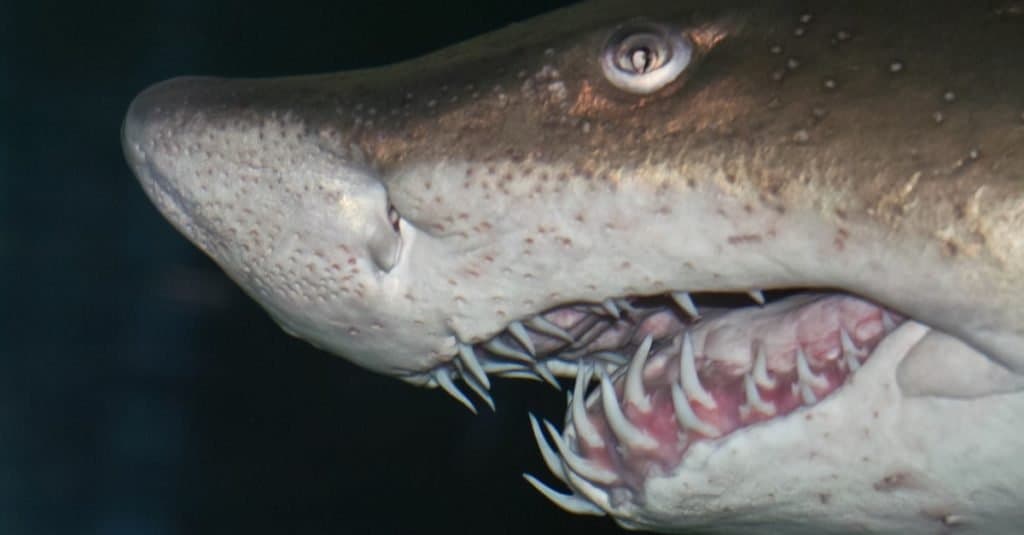
Sand
tiger
sharks have 36 attacks on humans with no fatalities
©MP cz/Shutterstock.com
Sand tiger sharks are also known as gray nurse sharks and ragged-tooth sharks. They are often spotted near the ocean floor. Their name is derived from the fact that they migrate toward shorelines and are often seen by surfers. They live in warm waters throughout the world. In total, there are three species of sand sharks which also include smalltooth sand tigers and bigeye sand tigers. The largest smalltooth sand tigers are about 10.5 feet long and weigh around 350 lbs.
Their hunting habits are quite unique. Sand tiger sharks collect air in their stomach from above the surface and become buoyant. This buoyancy allows sand tiger sharks to sit virtually completely still and approach prey undetected.
Similar to other shark species, they can detect electrical currents produced by prey with electroreceptors in their snouts. (Sharks’ smelling abilities are ranked in the top ten of the entire animal kingdom, including those on water and land.)
Sand tiger sharks are also night hunters and during the day they’re basically inactive. Their diet consists of mostly small fish but they also eat crustaceans and squid as well. Although humans aren’t their normal prey, sand tiger sharks are on record for having attacked 36 humans with no fatalities.
4. Blacktip Shark

Blacktip sharks have 35 attacks on humans with no fatalities
©Gino Santa Maria/Shutterstock.com
These sharks can be found year-round in the Gulf of Mexico and are also in the waters from Virginia through Florida as well as many other places in the world. Their pectoral, dorsal, and tail fins are black-tipped. They’re also one of the shark species that spin out of the water while feeding.
Their diet includes:
- Bony fish
- Smaller sharks
- Squid
- Stingrays and skates
- Shrimp
- Crabs
Blacktip sharks prefer shallow, clear water. They’re generally around 5 feet long and their average weight is 40 pounds. Their smaller size makes them no less formidable.
If they feel threatened, they will respond by:
A. Swimming straight toward the threat
B. Abruptly turning away and rolling side-to-side
C. Lowers its pectoral fins
D. Tilts its head and tail upwards
E. Make sideways biting motions
The entire behavioral show takes around 30 seconds. Although they don’t pose a significant threat to humans, they are on record with 35 human attacks and no fatalities. The blacktip reef shark is also listed with 14 human attacks and no fatalities.
3. Bull Sharks
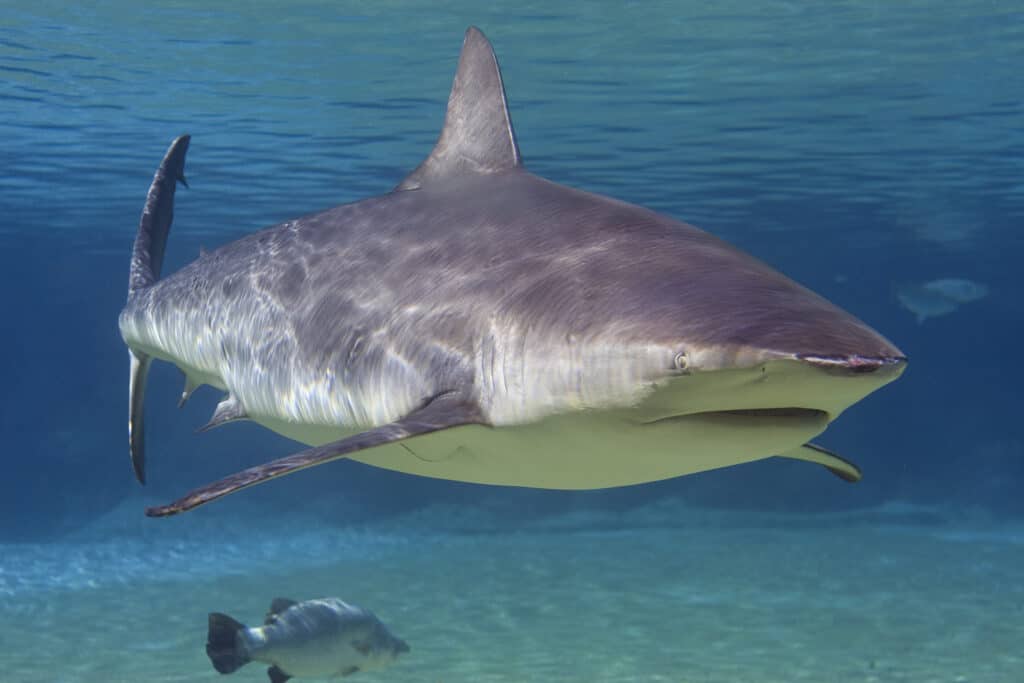
Bull sharks have 119 recorded human attacks with 26 fatalities
©Ian Scott/Shutterstock.com
In the United States, bull sharks are found off the East Coast and in the Gulf of Mexico. They’re extremely aggressive and can also be found in freshwater which has given them more access to humans.
Male and female Bull Sharks have quite the difference in size with males reaching about seven feet in length and females growing up to 11 feet. Adults can weigh from 200 to 500 pounds.
Adult bull sharks have no natural predators. While they have been observed feeding on plants and algae, the vast majority of what bull sharks eat consists of meat. Their diet includes:
- Fish
- Other shark species
- Sea turtles
- Sea birds
- Stingrays
- Dolphins
The jaw strength of bull sharks is formidable having a 6,000-newton bite force or around 1,300 lbs. of force. (Humans have from 247 to 292 lbs. of bite force.) They don’t have an appetite for humans but if they do attack, they normally break away after realizing it’s not their normal prey.
With that being said, bull shark aggression has resulted in 119 humans being attacked with 26 of them being fatal.
2. Tiger Sharks
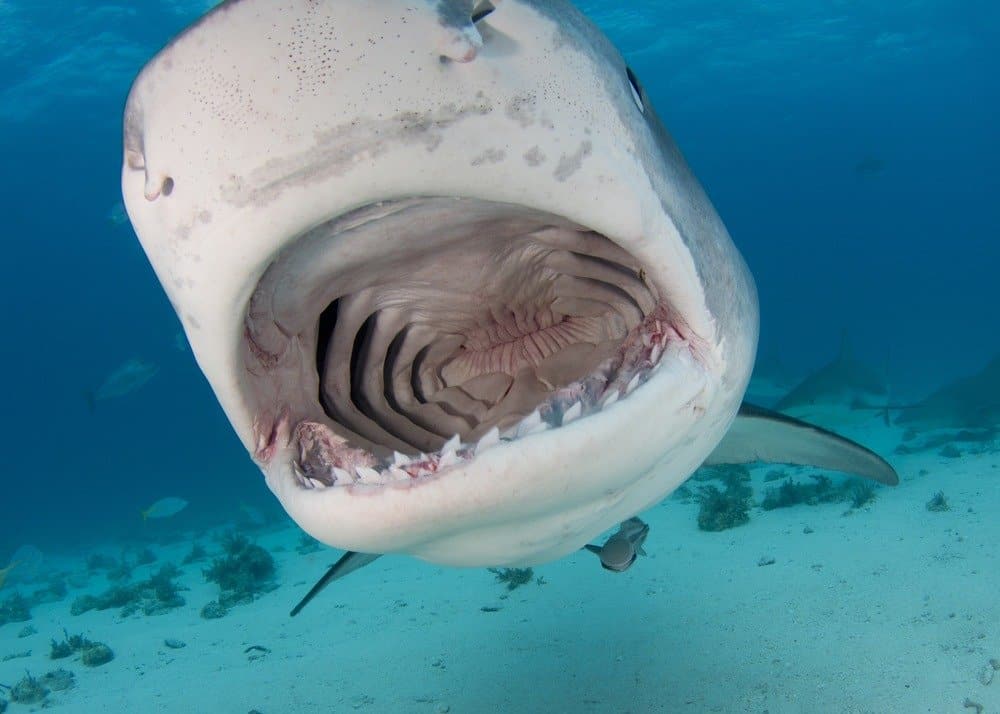
Tiger sharks have 142 attacks on humans and 39 fatalities.
©Matt9122/Shutterstock.com
A tiger shark gets its name from the dark stripes on its body when it’s younger that fade with maturity. Their size range is from 10-14 feet with females being larger than males. Large female tiger sharks can weigh 2,000+ pounds.
It is second in line, behind the great white, in recorded human fatalities having attacked 142 humans which includes 39 fatalities.
Tiger sharks feed mostly at night, close to shore, and eat the most varied range of prey of all sharks including:
- Fish
- Birds
- Seal
- Turtles
- Dolphins
- Sea snakes
- Squid
- Crustaceans
They could be called an ocean trashcan in that tiger sharks eat almost anything, living or not. The tiger shark’s teeth are unusually serrated and most are pointed in different directions. This weapon gives it the upper hand with prey since it can easily slice through shells and bones. Like most sharks, its rows of teeth are replaced throughout its life.
1. Great White Shark
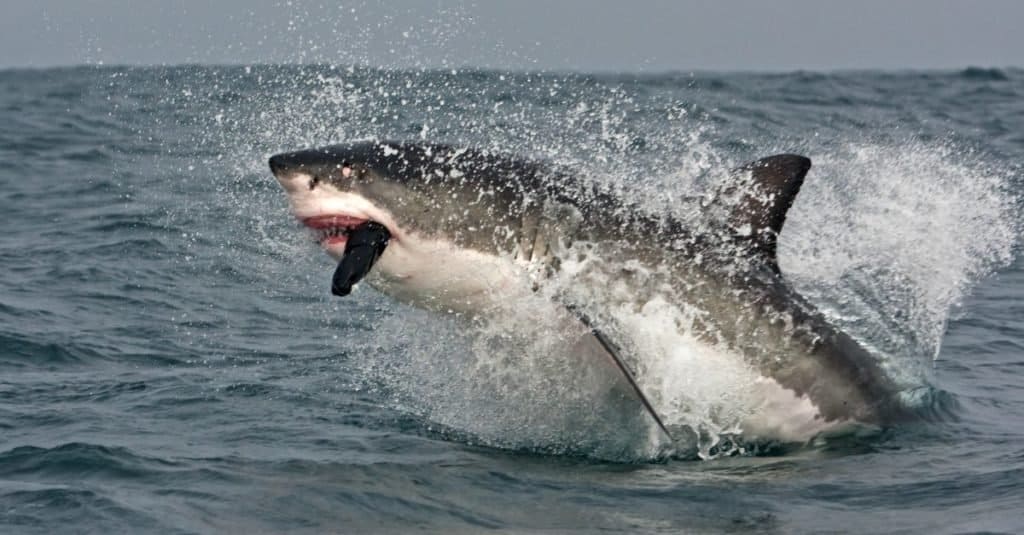
Great white sharks are the most aggressive sharks in the ocean today.
©Martin Prochazkacz/Shutterstock.com
Great white sharks are the most aggressive sharks in the world has recorded 351 attacks on humans, with 59 of them being fatal.
The inclusion of this particular species probably comes as no surprise since movies, particularly Jaws, and television shows are quick to show their aggression. And they would be partly right. Worldwide, the Great White is responsible for about ⅓ to ½ of the 100-plus shark attacks per year making them the number one of their species that do so. Although almost all of those are not fatal, it’s still a sobering statistic.
The fact is, when a great white shark spots a swimmer or surfer from below, they may not be able to differentiate them from their favorite meal, seals.
Human beings aren’t what white sharks normally stalk. They are carnivores though, able to swim up to around 35 mph, and eat mostly:
- Sea turtles
- Sea lions
- Seal
- Porpoises
- Dolphins
Great whites are excellent hunters. Their backs are bluish-gray, and their bellies are white. This makes them camouflage from above, resembling the color of water, and below, blending in with sand. With a speed of up to 15 mph, this shark can discreetly seek out its prey undetected and quickly. They have thousands of razor-sharp teeth, which provide a fatal bite.
The largest great whites are around 20 feet long and weigh between 1,500 and 4,000 pounds. The largest ever recorded great white is estimated to weigh 5,000 pounds!
- Note: The shark attack statistics accompanying each of these 7 most aggressive sharks are from the ISAF (International Shark Attack File) which is the world’s only scientifically documented, comprehensive database of all known shark attacks. Recordings began in 1958.
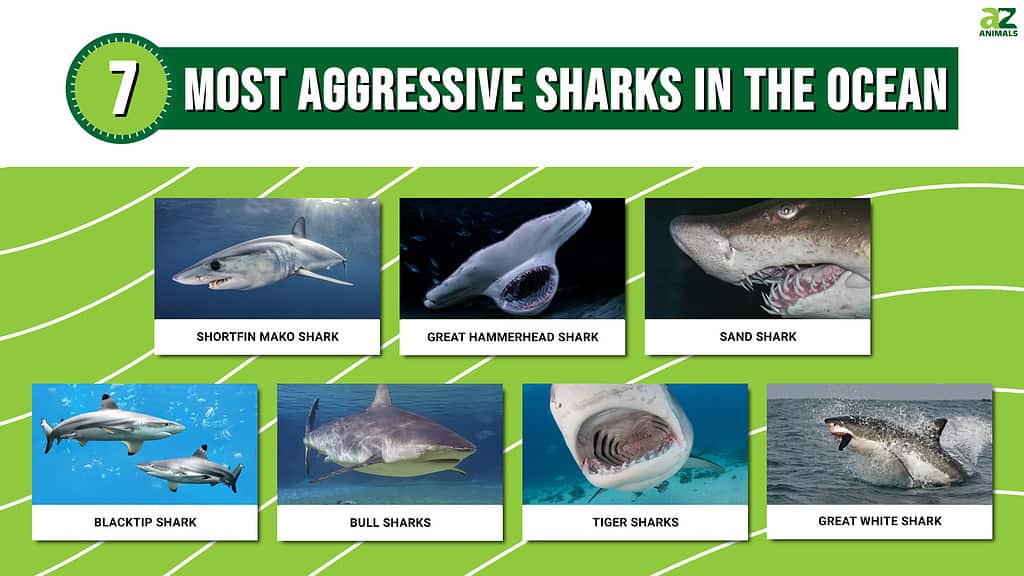
Hopefully, you’ve learned something new about these most aggressive sharks. You could say sharks aren’t a real danger to humans. But the people who have been attacked by one may think differently. With their torpedo-like bodies and seemingly emotionless eyes, it’s easy to see why people fear these creatures.
So what can we do? Our best bet is to have a healthy respect for sharks and behave cautiously when we’re in their world which would serve us well.
Refrain from excess splashing, particularly in a single spot. Sharks can hear the low-frequency sounds from splashing and may investigate to see if there is a fish/prey in distress. Do not enter the water if sharks are known to be present. Slowly and calmly evacuate the water if sharks are seen.
Thank you for reading! Have some feedback for us? Contact the AZ Animals editorial team.

